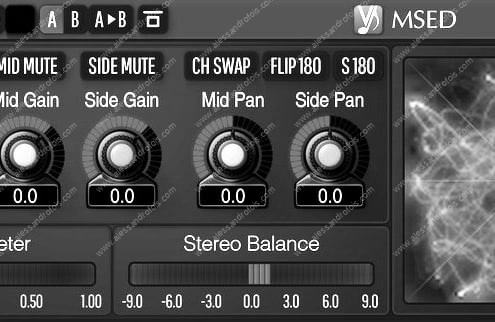MS Mastering
- Author Profile
- Recent posts
Pianist, Composer, Arranger, Sound Engineer, Writer, Blogger
Alessandro Fois is a musician, composer, pianist, arranger and sound engineer. Since 2018, he has also been a writer, blogger and webmaster. He currently resides in Ivrea (Turin) where, in addition to the above activities, he manages Lycnos, studio for audio, video and web services, and the recording studio Glamour Recording Studio.
MS MASTERING
The so-called M/S Mastering involves the execution of certain types of processing operations, executable between one encoding and another decoding operation of the mix, which transforms the L-R matrix (Left-Right) in a M/S matrix (Middle/Side) and vice versa, such that we can independently filter the central (M - Middle) and side elements of the L/R stereo image (S - Side); hence the acronym MS.
To do this, if the convenient plugins for encoding (before the process) and decoding (at the end of the process) are not available, a specific and relatively complex audio path must first be constructed on our daw.
The MS chain
Basically, it is a matter of installing in our mix track a complete M/S matrix aimed at alternative audio processing.
It will consist, in order, of:
- a M/S encoderfor transforming the L-R signal into M/S encoding
- a unit of M/S processing, i.e. 2 parallel chains of tone and dynamics processors in plugin form, one of which is dedicated to M-channel processing and the other for the S-channel
- a M/S decoder, to transform the M/S signal back into L-R during and after processing, so that we can monitor and correctly utilise the result of our manipulations carried out in the M/S domain
L-R to M/S encoding
Starting from our original L-R mix, this is the first step to take, which will allow us to break down the L-R stereo sound by applying the following formula:
M (Middle channel) = 1/2 (Left + Right)
would be to say that the Middle channel is obtained by mixing the Left channel with the Right channel at equal volume to an aux bus, and then attenuating the result by -3dB
S (Side channel) = 1/2 (Left - Right)
would be to say that the Side channel is obtained by mixing at equal volume to an aux bus the Left channel with the Right channel (the latter, however, with inverted phase polarity), and then attenuating the result by -3dB

Diagram of the digital signal path required for L-R to M/S encoding and reverse decoding, without using a convenient plugin encoder/decoder pair. Note the audio path articulated by means of bus assignments. The equalisers were used exclusively for phase inversion, which they support.
M/S Processing
Between the encoder and decoder we can install, for each of the M and S channels on the relevant aux bus, a equaliser and a compressorbut possibly others processors as needed in order to manipulate the audio thus decomposed, before recomposition via the decoder.
A description of some of the most typical audio manipulations executable by means of theM/S processing is described later in this chapter.
M/S to L/R decoding
At the end of the processing carried out in the M/S matrixto reconstitute the L-R stereo matrixthen itself usable for further processing and for exporting the master, the following inverse formula must be applied:
L = M + S
would be to say that the Left channel is obtained by mixing the Middle and Side channels on an aux bus at equal volume.
R = M - S
would be to say that the Right channel is obtained by mixing in an aux bus, at equal volume, the Middle channel and the Side channel (the latter after inverting their phase polarity)
How to set up the matrix M/S on Daw
According to the characteristics of Daw there are three ways to operate.

The same audio chain as in the previous image in an edit screen, which allows better visualisation of connections and clarification of concepts.
Here they are:
1 - If you have a plugin with M/S encoder functions, you can do this:
- install it directly on the mix bus insert (conveyor track of the entire mix)
- then in the insert chain install the processors to be used for the appropriate manipulations in the M/S environment, making sure that they can be set in dual mono, in order to allow independent adjustments for the two channels M and S
- at the end of the chain, install a plugin with reverse function of M/S decoder
2 - if you have a plugin with M/S encoder functions but you don't have processors running in dual mono:
- install the M/S encoder directly on the mix track insert
- route the 2 M and S outputs of the plug-in to 2 mono buses that you call M and S
- On these independent buses M and S install the processors to be used for sound manipulation, independently for the 2 channels M and S;
- channel the mono outputs of the 2 M and S buses into a 'stereo' bus, into which you will install the M/S decoder, in order to convert the M/S matrix into an L/R one
3 - finally, if you do not have the aforementioned encoding and decoding pluginsThings get a little more complicated, because you will have to manually create the correct signal paths and perform some inversions of phase polarity, which are indicated below:
Encoding
- transport a copy of the original stereo mix, spreading it over 2 separate mono tracks (L and R, which we will now call A and B) and keeping the pan-pot of both tracks A and B in the centre
- Decrease the volume of the two tracks A and B, each by 6 db, and channel them at equal volume into a mono bus that we will call M (Middle), which will be our centre channel
- repeat operation 'a', transporting a second copy of the mix on a further 2 distinct mono tracks (L and R, which we will now call C and D), again keeping the pan-pot of both at the centre
- Reverse the phase polarity of track D only (R), either by means of a phase inverter (which is sometimes available on the track controls themselves) or by means of a special plugin with a polarity inversion switch, to be installed on the track (such a switch is often available in eq plugins)
- decrease the volume of the 2 tracks C and D, each by 6 db, and channel them into a mono bus that we will call S (i.e. Side), which will be our bi-lateral channel
- by means of these operations, you will have obtained two separate mono buses with their respective M and S channels,
Processing
- a chain of processors can be installed on each of the aforementioned M and S channels, as required and independently for each channel
- after processing, however, we must restore the L and R stereo image so that we can monitor processing operations and use the sound obtained in the M/S domain in a normal L-R matrix
Decoding
- channel the outputs of the two buses M and S into another mono bus and you get channel L
- feed other parallel outputs of the same M and S buses (if you do not have them, you can use the aux sends of the bus) into two other mono buses and invert the phase of the S bus only
- Now feed the outputs of the M and S buses together (the latter with the phase reversed, therefore) into a single mono bus, and you have obtained the R channel
- Finally, channel L and R thus obtained into a new stereo bus that we will finally call L -R, and that's it
it is a complex operation, but not difficult to perform, if you follow the instructions step by step.

Voxengo's MSED is a professional AAX, AudioUnit and VST audio encoder and decoder plug-in for mid-side processing that can encode (split) the incoming stereo signal into two components: mid-side pair and vice versa: decode mid-side pair into stereo signal; it is also able to operate in 'inline' mode with the ability to adjust the gain and panning of the centre and side channels without the need to use two plug-in instances in sequence. It can be used to flip the phase of the centre and side channels by 180 degrees, invert the stereo channels, and extract the centre or side channel. It is equipped with a 'plasma' vector oscilloscope, stereo correlation control and balance meters that facilitate the monitoring of stereo information in the audio signal.
Let us now analyse what advantages we can obtain by processing the channels of the M/S matrix with equalisers, compressors and volume controllers inserted between the encoder and the decoder.
Mastering operations with the M/S matrix
By acting independently and appropriately on the volumes of the M and S channels we can achieve certain improvements, which would not be achievable without this technique.
Let us look at some of the most typical ones.
Adjusting the relationship between spatiality and presence
- By varying the ratio of volume between the central and bi-lateral channels, an overall effect of greater presence and 'concreteness' (by raising the volume of the central M-channel) or more spacing (by raising the volume of the lateral S-channel) will be achieved.
Straightening an unbalanced stereo image
- By varying the setting of balance of the individual L and R channels input on the S channel (during encoding)
Increasing presence and definition without taking away space
- With theequaliser High Shelf it will be possible to make 'rooms' wider and brighter simply by increasing the clear frequencies in the S channel, without touching the body balances of the main instruments in the M channel.
- By means of the compressor it will be possible to compress slightly with a few dB of reduction (e.g. 2 or 3 db) the S channel only, in order to contain the ambient effects during the most intense parts of the musical performance, letting them manifest themselves more in the most relaxed and rarefied points; this will increase definition and presence without taking away spatiality. This effect can be more pronounced by using a sidechain compressor that compresses the S-channel according to the stresses of the signal present in the M-channel. These compression techniques can also be used to achieve a compensatory effect in cases where, having chosen to turn up the volume of the S-channel to increase the spatiality of the mix, you wish to keep the original feeling of presence intact.
- With theequaliser you could lighten the bass in the side image, adequately compensating for it by boosting in the centre channel, resulting in a firmer sound in the lower frequencies; this artifice can help improve the readability of the bass range and the entire mix. Alternatively, depending on the case, it may be interesting to attenuate the 'muddy' band between 200 and 400 Hz.
Optimising turntable needle performance
In the case of mastering for vinyl record production, the total elimination of the lateral image in the low frequencies, which can be achieved using theequaliser according to the technique mentioned in point no. 3 above, can become decisive for a more stable stylus set-up of the turntable, resulting in a more accurate and sharper sound, and also avoiding any risk of the stylus 'jumping' out of the groove, without increasing the weight adjustment of the turntable 'arm'.
Improving tonal control between mix elements
The possibility of equalising the M and S channels separately will allow us, in part, to improve and balance the sound of the most important elements of the mix against the other elements and the environment.
To give one example among many: we can intervene on the M channel to increase the presence of the vocals and snare drum in the mid-high range and at the same time to increase the bass on the kick drum and bass guitar, without appreciably affecting the other elements of the mix and the ambience.
Should the intervention described in the example produce an excessive tightening in the mid-high range and confusion in the bass, we can partly compensate for this by attenuating the same frequencies in the S channel.
In this sense, with much circumspection and restraint we could try various compensatory experiments in order to improve readability and tonal balance, as an alternative to the normal tonal and dynamic correction operated in the L-R environment during mastering.
Increasing the loudness of the mix without affecting the rooms
Anyone who has tried to compress a master knows that high ratio values can induce a 'pumping' effect, which is especially noticeable on reverberation, an inconvenience to be contained through very careful use of the release parameters.
Instead, compressing only the M channel (in which reverberations have less presence) this inconvenience will be almost completely eliminated, allowing the use of harder compressions for the most critical elements of a pop-rock-dance mix, i.e. the soloist (e.g. vocals), bass, kick and snare.
Obviously, it will be appropriate to compensate for the compressor-induced volume reduction by means of the make-up control (compressor output volume), in order to restore the pre-compression volume balance.
With this compression operation, great restraint and care is needed to avoid compromising and distorting too much the original balance of the mix.
If the effect proves to be unnatural, you can try reducing the ratio or compressing the S channel slightly (to a lesser extent).
Conclusion
- La matrix M/S for mastering can be inserted at any point in the normal plugin chain: i.e. before, in the middle or at the end of it, according to the needs arising during the mastering process itself
- It will also be possible to open several M/S arrays along the chain, for example:
- one at the beginning, dedicated to volume correction of the centre channel;
- after tonal correction, a second one dedicated to the refinement of tonal correction;
- and maybe even a third one after the dynamic correction, dedicated to the refinement of the dynamic correction and the handling of up to the stereo image.
- However, unless it is particularly necessary, it may be advisable to limit the use of this technique in order not to make the digital chain too heavy, also to prevent any possible cause of sound degradation.
- Finally, during and at the end of the operations, a comparison with the original mix will be appropriate.
N.B.
Some of the aforementioned processes (but not all) can be extremely simplified by using some simple plugins (such as 'Waves Center' and 'Waves S1 Stereo Imager'). After installation in a chain on the mix track, they will allow us to perform these functions with extreme convenience, offering us an immediate and intuitive result, albeit with some functional limitations.






Leave a Reply
Want to join the discussion?Feel free to contribute!